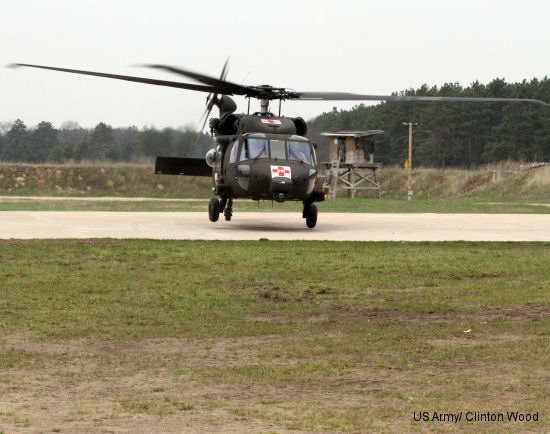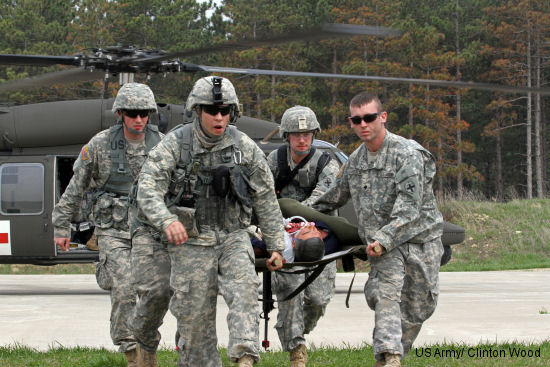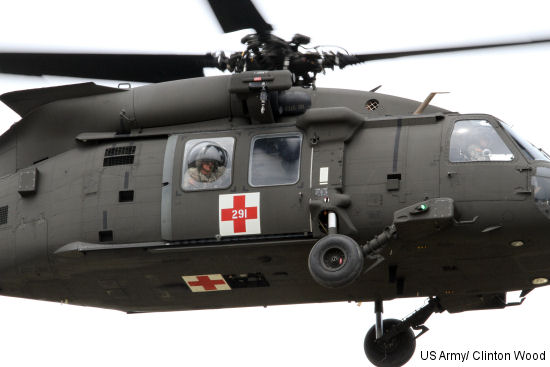US Army, May 27, 2014 - FORT MCCOY, Wis. by Clinton Wood, 84th Training Command - During the week, Ryan Brock of Newark, Delaware, cuts mattes for picture frames at his parent’s art gallery and frame shop.
As an Army Reserve captain, Brock slices through the air in one of the newest Black Hawk helicopters in the Army inventory, a HH-60M Medevac helicopter
This helicopter’s “state of the art medical” features include onboard oxygen making capabilities, medical suction and an external electrical rescue hoist.
Brock, who is one of the few 67J Aeromedical Evacuation Officers in the Army Reserve, said, “It is busy. If you stop your learning path you are going to die. You have to focus all the time and stay up on the many aspects of both military and civilian flight regulations as well as aircraft knowledge.”
The latest exercise that Brock and his team honed its skills on was the 86th Training Division’s Combat Support Training Exercise/Global Medic from April 26 until May 13 on Fort McCoy, Wis. More than 6,000 Service members participated in this collective exercise overseen by the 84th Training Command, Fort Knox, Ky. This exercise evaluates military units who may or may not be deploying on their warfighting and specific Military Occupational Specialty skills in combat scenarios.
Brock’s company is Company F, 1st Battalion, 214th Aviation Regiment, part of the 11th Aviation Command, Fort Knox, Ky., and split based at Johnstown, Pa., and Fort Knox. It also is one of only three Medevac Companies in the Army Reserve. It not only flew Medevac missions day and night during the eight-day Field Training Exercise from May 6 until May 13 but days prior to the FTX, it executed Medevac 101 classes with a static helicopter. More than 200 soldiers, Sailors and Airmen underwent the training.
“Service members learned the proper technique for loading a litter into the aircraft and the capabilities that Medevac brings to the fight,” said Brock.
Brock said these classes allow the litter carriers to practice non-verbal communication skills because when the helicopter’s engines are running, they will not be able to hear each other. It also teaches them to communicate with the flight paramedic when he evaluates a casualty at the landing zone.
The FTX saw several medevac operations using mannequins, and service members and military working dogs with simulated wounds strapped to the litters.
For some of the litter carriers, it was their first time loading “patients” unto a helicopter with its engine running.
Private Derrick Abaka, a marketing company consultant from Blacklick, Ohio, Company A, 256th Combat Support Hospital, Columbus, Ohio, described the rotor wash created by the helicopter landing as a “whirlwind.”
“It felt so real as if I was in a combat zone,” said Abaka, a supply specialist who graduated from Advanced Individual Training in January.
For Spc. David Lin of Seattle, Washington, a Behavior Health Specialist for the 1972nd Combat Operational Stress Control Detachment, Fort Lewis, Washington, observing these evacuations brought back memories. He witnessed them while deployed to a Forward Operating Base in Afghanistan from 2012 until 2013.
‘But I think it is good training for Soldiers who have not been there or done that, it gets them in the mindset of the real thing,” said Lin.
The training also was beneficial to crew chiefs, said Brock, whose father flew UH-1 Huey and Cobra helicopters in the Vietnam War. He noted that a crew chief on a Medevac helicopter must assist the flight medic in placing the casualty onto an electric litter pan (there are at least two of these on each side of the helicopter) as well as enroute care. There is not much room in the helicopter’s belly to maneuver.
Brock said there also is the possibility of a casualty spitting up blood. He added that flight medics are familiar with this possibility but not so for crew chiefs.
“It is not something they signed up for,” said Brock. “You get someone doing something they didn’t sign up for and it will be interesting,” he said. “Because they are out of their element.”
Flight paramedics are definitely in their element. After graduating from a five-week flight medic school at Fort Rucker, Alabama, they must attend a 34-week U.S. Army Flight Paramedic Course that includes eight weeks of Critical Care Clinical Skills. The Critical Care Clinical Skills course has been added recently.
Flight medic Sgt. Chris Bignami, a civilian paramedic in West Isup, New York, said this new course allows inflight medical care that includes pushing blood to patients and placing casualties on ventilators. He was among the 26 graduates of the inaugural course at the University of Texas, Health Sciences Center, San Antonio, Texas, in February 2012.
Flight medics can also administer Intravenous therapy or IVs while transporting patients.
Brock said having his flight medics practice this in the back of a helicopter is very beneficial.
“Usually on the ground, it is very stable but in the air you have noise and movement,” said Brock of administering IVs. “This kind of exercise provides a good opportunity to practice in such an environment.”
Practice makes perfect and in this case, it will assist this pilot and his crew in honing its skills and saving lives.
As an Army Reserve captain, Brock slices through the air in one of the newest Black Hawk helicopters in the Army inventory, a HH-60M Medevac helicopter
This helicopter’s “state of the art medical” features include onboard oxygen making capabilities, medical suction and an external electrical rescue hoist.
Brock, who is one of the few 67J Aeromedical Evacuation Officers in the Army Reserve, said, “It is busy. If you stop your learning path you are going to die. You have to focus all the time and stay up on the many aspects of both military and civilian flight regulations as well as aircraft knowledge.”
The latest exercise that Brock and his team honed its skills on was the 86th Training Division’s Combat Support Training Exercise/Global Medic from April 26 until May 13 on Fort McCoy, Wis. More than 6,000 Service members participated in this collective exercise overseen by the 84th Training Command, Fort Knox, Ky. This exercise evaluates military units who may or may not be deploying on their warfighting and specific Military Occupational Specialty skills in combat scenarios.
Brock’s company is Company F, 1st Battalion, 214th Aviation Regiment, part of the 11th Aviation Command, Fort Knox, Ky., and split based at Johnstown, Pa., and Fort Knox. It also is one of only three Medevac Companies in the Army Reserve. It not only flew Medevac missions day and night during the eight-day Field Training Exercise from May 6 until May 13 but days prior to the FTX, it executed Medevac 101 classes with a static helicopter. More than 200 soldiers, Sailors and Airmen underwent the training.
“Service members learned the proper technique for loading a litter into the aircraft and the capabilities that Medevac brings to the fight,” said Brock.
Brock said these classes allow the litter carriers to practice non-verbal communication skills because when the helicopter’s engines are running, they will not be able to hear each other. It also teaches them to communicate with the flight paramedic when he evaluates a casualty at the landing zone.
The FTX saw several medevac operations using mannequins, and service members and military working dogs with simulated wounds strapped to the litters.
For some of the litter carriers, it was their first time loading “patients” unto a helicopter with its engine running.
Private Derrick Abaka, a marketing company consultant from Blacklick, Ohio, Company A, 256th Combat Support Hospital, Columbus, Ohio, described the rotor wash created by the helicopter landing as a “whirlwind.”
“It felt so real as if I was in a combat zone,” said Abaka, a supply specialist who graduated from Advanced Individual Training in January.
For Spc. David Lin of Seattle, Washington, a Behavior Health Specialist for the 1972nd Combat Operational Stress Control Detachment, Fort Lewis, Washington, observing these evacuations brought back memories. He witnessed them while deployed to a Forward Operating Base in Afghanistan from 2012 until 2013.
‘But I think it is good training for Soldiers who have not been there or done that, it gets them in the mindset of the real thing,” said Lin.
The training also was beneficial to crew chiefs, said Brock, whose father flew UH-1 Huey and Cobra helicopters in the Vietnam War. He noted that a crew chief on a Medevac helicopter must assist the flight medic in placing the casualty onto an electric litter pan (there are at least two of these on each side of the helicopter) as well as enroute care. There is not much room in the helicopter’s belly to maneuver.
Brock said there also is the possibility of a casualty spitting up blood. He added that flight medics are familiar with this possibility but not so for crew chiefs.
“It is not something they signed up for,” said Brock. “You get someone doing something they didn’t sign up for and it will be interesting,” he said. “Because they are out of their element.”
Flight paramedics are definitely in their element. After graduating from a five-week flight medic school at Fort Rucker, Alabama, they must attend a 34-week U.S. Army Flight Paramedic Course that includes eight weeks of Critical Care Clinical Skills. The Critical Care Clinical Skills course has been added recently.
Flight medic Sgt. Chris Bignami, a civilian paramedic in West Isup, New York, said this new course allows inflight medical care that includes pushing blood to patients and placing casualties on ventilators. He was among the 26 graduates of the inaugural course at the University of Texas, Health Sciences Center, San Antonio, Texas, in February 2012.
Flight medics can also administer Intravenous therapy or IVs while transporting patients.
Brock said having his flight medics practice this in the back of a helicopter is very beneficial.
“Usually on the ground, it is very stable but in the air you have noise and movement,” said Brock of administering IVs. “This kind of exercise provides a good opportunity to practice in such an environment.”
Practice makes perfect and in this case, it will assist this pilot and his crew in honing its skills and saving lives.
See also |
Sikorsky HH-60M Black Hawk







